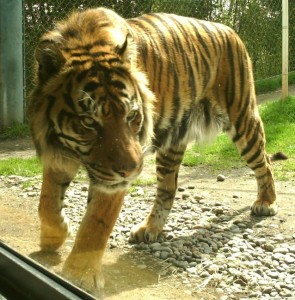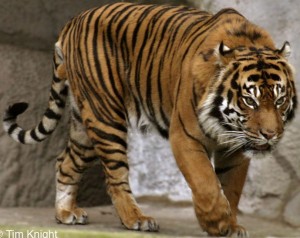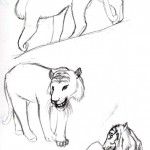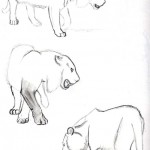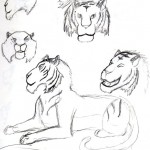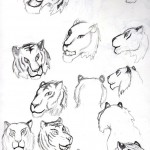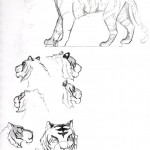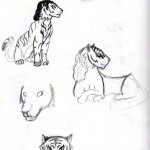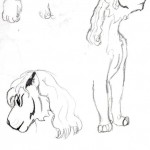Panthera tigris sumatrea Observations at Point Defiance Zoo by Keiko
Sumatran tigers are a subspecies of tiger. There are 6 living subspecies of tigers: Sumatran, Bengal, Siberian, Indochinese, Malayan, and South Chinese. There are less than 400 Sumatran tigers left in their natural habitat. Males only get up to 300lbs and 8ft from nose to tail tip and females get up to 200lbs and only 7ft long; that makes Sumatran tigers the smallest of the subspecies. The largest is the Siberian, which can weigh upwards of 770lbs! Their range of habitat is only in the Indonesian Islands of Sumatra. Their stripes are thinner than the other kinds of tigers, but occur more, and they have a more bearded appearance, especially the males, than other tigers. They have spots and specks of black on the feet and at the end of many of their stripes. They also are the only tigers that have webbing between their toes for swimming. It is thought that that is how they got to Sumatra and then they developed even more through the years of isolation on the island. Sumatran tigers swim so well that they often chase their prey into the water where they can’t move as well as the tigers. Sumatran tigers also have a darker orange color than the other subspecies.
I originally chose Clouded Leopards because the Point Defiance Zoo just had two cubs born, but the access to them was very limited and not very conducive to our assignment. I found out the zoo had Sumatran Tigers and chose them instead. I wanted to take the opportunity to study something I don’t get much of chance to see. It would have been easier to study horses because there are a few horses in walking distance to where I live, but I couldn’t pass up the chance to study exotic animals at the zoo. It’s not that I like tigers any less than the Clouded Leopards just because I chose tigers as my back up; I really do love all the big cats. The specific tiger I am studying is named Bali. He’s a 14/15 year old who I found out was actually receiving chemo treatments for lymphoma, treatments for some renal problems, and arthritis. I choose him because he was the first tiger I saw at the zoo and is one of the tigers who is out the most.
Kingdom: Animalia
Phylum: Chordata
Class: Mammalia
Order: Carnivora
Famliy: Felidae
Genus: Panthera
Species: tigris
Subspecies: sumatrae
 [4]
[4]
Natural History – Tigers
Tigers, Panthera tigris, are the largest of the big cats alive today. They used to be found mostly in central and South Asia, from the southern parts of Siberia to Sumatra. However, because of hunting for their gorgeous fur and destruction of their natural habitat, tigers hit the level of being nearly extinct in 1997 when their numbers reached an all time low of 5,000-6,000 in the wild. In 1930, there used to be 40,000 Bengal Tigers in India alone. All tigers came from South and South East Asia and now roam in Asia, lower Russia, and Africa. And an interesting tidbit of information: white tigers are NOT a separate species, just a genetic variation. There are also mostly white tigers called “ghost tigers” which have either very, very light striping or none at all!
Sumatran Tigers –
Sumatran Tigers are the smallest and rarest subspecies of tiger in the world. Males are typically 220-300lbs and about 7.25-7.4ft. Females get to about 170-240lbs and are 7-7.6ft in length. Their tails are about half the length of their bodies. In 1998 there were only about 500 Sumatran Tigers left in the wild and about 235 in captivity. They are the smallest of the subspecies because on the island of Sumatra the forests are very dense and thick, so they have evolved to fit that environment better. Their bodies are thick and angular and you can easily see that most of their body is in a rectangular shape. When they sit they are curvier but still quite angular. Their faces, framed by their manes, have a tendency to look hexagonal, triangular, or rounded. Sumatran Tiger skulls are long and broad. Their coats range from a reddish yellow to a dark organge. Their eyes are yellow and they can see in color. Their whiskers are very long which help when searching in the dense forests. They hunt and see very well in the dark. Tigers actually have the largest canine teeth of all land carnivores. Their tongues are much like a house cats, which have rough Papillae that help them take skin and meat of bones. Their claws retract just like all other felines (except Cheetahs). They are good climbers and their back legs are longer than their front legs, which help them pounce. They can run as fast as 43 mph for short distances. A group of tigers is called a streak.
Skeletal Structures:
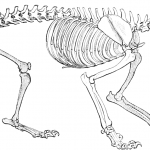 [5]
[5]  [6]
[6] 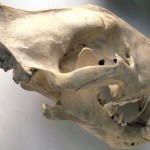 [7]
[7]
My Drawings of the Skeletal Structures:
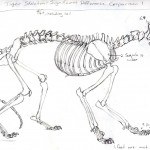


Sumatran Tigers are the last survivors of the Sunda Island tigers. The other subspecies that lived there are the Balinese and Javan tigers, which are now extinct. Unfortunately, most of the Sumatran tigers left are in park reserves and the few that are outside these ranges are in great danger of being poached or succumbing to agricultural development. Even though Sumatran Tigers are protected in Indonesia by law, the demand for tiger parts is still high. In 1978, it was recorded that there were about 1000 Sumatran Tigers left in the wild. Now there are as few as 400.
Vocalizations:
- Chuffing (cross between blowing and purring)
- Bellows
- Hisses
- Roars
Distinguishing Characteristics:
- Smallest of subspecies
- Spots near ends of stripes and on back, flanks, and hind legs
- Higher frequency of stripes
- Thicker stripes
- Webbed toes (only subspecies of tigers to have them)
- Darkest coat colors of all subspecies
- Maned and Bearded appearance, especially males
Behaviors:
- Mostly nocturnal, but also active in the day, especially during winter
- They do not hibernate
- Generally don’t move much except for hunting, playing, fighting, and mating
- Use ambush and stalking for hunting
- Mainly use front paws/arms and teeth when taking prey down
- Will occasionally gather to share a big kill
Diet and habitat –
Tigers normally eat small to medium sized game like deer, tapirs, antelopes, wild boar, and other small animals. Sumatran tigers live only on the eight providences/islands of Sumatra. Because they have webbed toes, Sumatran Tigers are very good swimmers and will even herd their prey into water where their prey is slower. Their habitat is dense jungle, lowland forests (what little remain), peat swamps, and freshwater swamps. The jungle forests are being plundered for timber and minerals and the farmers are moving in and taking over the land, thus leaving less and less room for the tigers. Any tigers that have eaten humans, so called “man-eating tigers,” have done so generally because they have been injured and need an easier meal or because their natural food supply is really low. Tigers need a 10-30 (or more) square mile territory to supply them with enough prey to live on. Territory size depends on amount of available prey.
 [8]
[8] 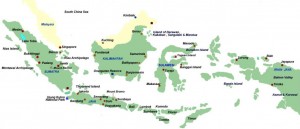 [9]
[9]
Mating –
Time period and relationships: Only a few days, but mate as many as 100 times during that time. All tigers are solitary creatures, but when they mate they are monogamous.
Period of gestation: 14-15 weeks
Litter & cub size: 1-6 cubs (usually only 2), 3lbs, 5oz – 7lbs, 11.5oz
Cub Care Taking: 1.5 years
Sexual Maturity: Females 3yrs, Males 4yrs
Life span: 20-25 years (in the wild or captivity)
Evolution –
Sumatran Tigers were isolated from the others between 12,000 and 6,000 years ago (Pleistocene to Holocene era) and have genetic markers that other tigers do not, which suggests that they are indeed a different species. The first picture below is of 4 different phylogenic trees based on different DNA evidence and showing the relationship between tigers and other big cats. The next three pictures below are two different diagrams showing how Sumatran Tigers relate to the other subspecies of tigers.
 [10]
[10]  [11]
[11]  [12]
[12]
Tigers in Culture:
Legends and Myths around the world:
Tigers are part of what is called “charismatic megafauna,” which “are large animal species with widespread popular appeal.” (*info from Wikipedia)
Japan – Even though there haven’t been tigers in Japan for about 6,000-12,000 years, they were in China and were regarded as either pests or legendary beasts like elephants and gryphons. In Buddhism the tiger is one of the Three Senseless Creatures, which are animals ruled by a more basic human emotion. The Three Senseless Creatures are the tiger who represents rage and anger, the monkey represents greed, and the deer represents lovesickness. Representations of tigers in anime (Japanese cartoons) are everywhere; like the 1970’s comic Tiger Mask; Thunder Cats, Fruits Basket, Fushigi Yuugi, Yu Yu Hakusho, Yami no Matsuei (Decedents of Darkness), and a million others. Often they are portrayed as fierce and/or guardian characters. In the world of tattoos, tigers are one of the most popular images. For hundreds of years, Japan has used ideas and concepts from China and the symbols of yin and yang are represented as tiger and dragon, respectively.
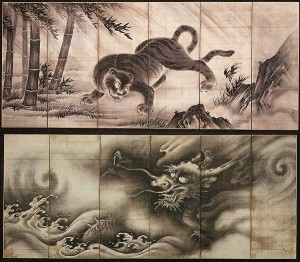 [13]
[13]  [14]
[14]  [15]
[15]
China – Tigers are a personification of war, warfare. They are used as a symbol of the highest general and also represent fearlessness, loyalty, and wrath. A form of Chinese martial arts is “tiger” style. There are many proverbs referencing tigers, here is one: “One hill cannot shelter two tigers.” This means, like real tigers (they do not associate with other tigers, they have their own home ranges, but are keenly aware of others) powerful people in China were referred to as tigers and a powerful person will stay in his own “hunting grounds.” The tiger is part of the Chinese Zodiac and represents competitiveness, pride, and abilities as a hunter. As one of the Four Constellations, the White Tiger of the West is associated with autumn. The markings on the heads of tigers look like the Chinese character 王, which is the symbol for “king.”
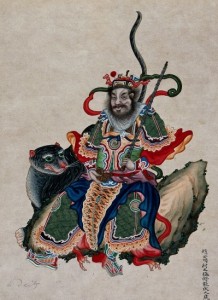 [16]
[16]
India – “Weretigers” are described as perilous sorcerers who prey on livestock and might eat a man as soon as look at one. Durga is a Hindu goddess with ten arms who rides a tiger named Damon. Paintings depicting tiger skins are also part of India’s mythology.
 [17]
[17]
Other Cultures:
Indonesia – In some legends weretigers, unlike in India, are considered to be compassionate guardians of plantations, protecting the crops from wild pigs.
Korea – Korea had three main belief systems about the tiger: 1. A holy guardian spirit of the nation and mountain god that can influence a person’s fate; 2. A fearsome creature that must be avoided at all costs; and 3. A clumsy animal used for satire and humorous folktales.
 [18]
[18]
Siberia – In the fairly undefined region of Siberia, the Tungusic people revere the tiger like a deity called “Grandfather” or “old man.”
Modern Representations:
The most well known tigers in modern pop-culture have got to be:
Shere Khan from Disney’s adaptation of Kipling’s book The Jungle Book;
 [19]
[19]
Tony the Tiger of Kellogg’s Frosted Flakes cereal brand and made by Sam Goldsmith in 1952;
 [20]
[20]
Tigger from Winnie the Pooh;
 [21]
[21]
Other representations:
Satire by Thomas Nast about the scandals in New York involving the corruption in the Tammany Hall-controlled Democratic running.
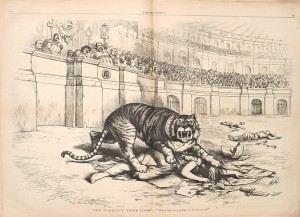 [22]
[22]
THE TAMMANY TIGER LOOSE! – “What are you going to do about it?”
Tigers have been in our lives since time immemorial and continue to be, even in a world where they are struggling to survive. Many young people today are still fascinated with tigers and other powerful predators. Here are some pieces of artwork made by the younger generation:
Fruits Basket (Japanese Anime) – female character in animal form:
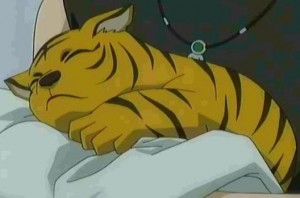 [23]
[23]
Weretiger from an artist on DeviantArt:
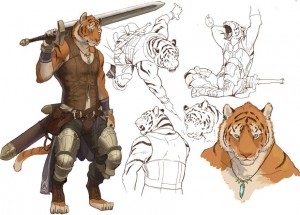 [24]
[24]
Anthropormorphized Shere Khan and Bagheera from The Jungle Book and by an artist on DeviantArt:
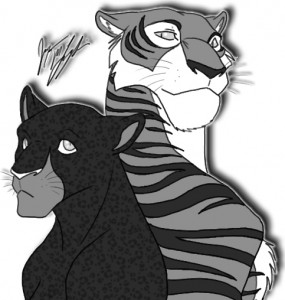 [25]
[25]
My Observations:
Photographs and video by me taken at Point Defiance Zoo
Bali: (15 years old, male, my main focus)
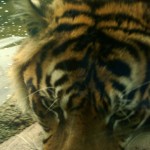
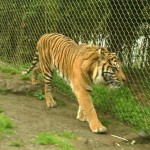



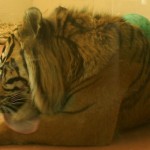


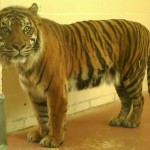
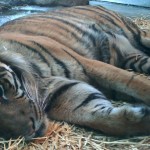


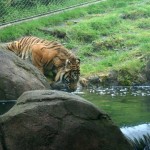


Bima: (2-3 years old, male, Bali’s son)
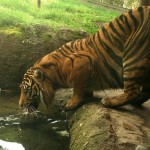
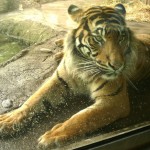
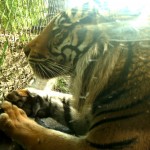
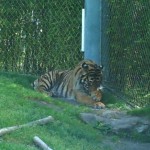

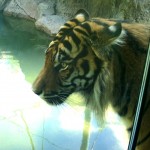

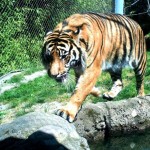

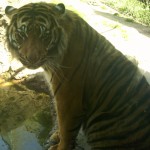
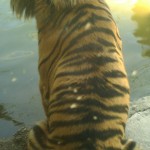
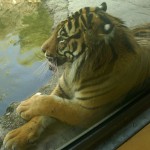
Malosi: (3 years old, male, the new one from Hawaii)
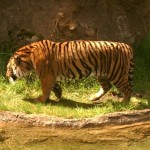

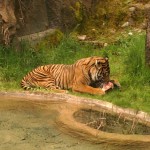
My Drawings from Observations:
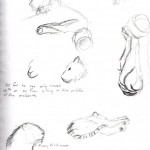
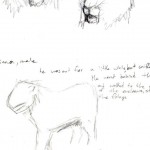
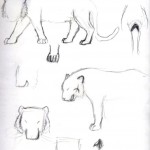
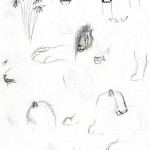
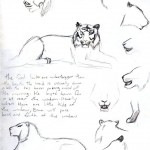
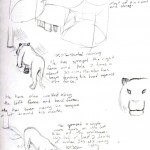
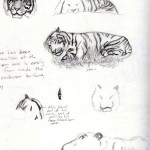
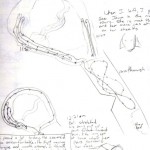
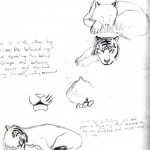

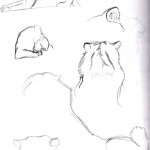


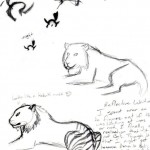
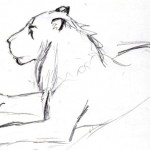
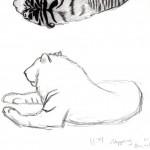
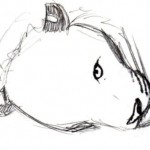
Excerpts of my Observations
Observations #1: 4-13-12
Bali, Male: very thick mane pg 9
Bima, Male: they stretch just like house cats pg 15
Observations #2: 4-18-12
Bima – 18 months old, male, son of Bali pg 22
Malosi – 2-3 yrs old, male, mate of Jaya pg 22
Bali was not out today so I’m studying Bali’s son, Bima, and the new mate for Jaya (the female), Malosi. Bima is in the small enclosure to the left of the larger, main enclosure. Malosi is in the main enclosure. Pg 22
Bima paced a lot. He hardly ever stood still. Pg 23
The front limbs are wider/bigger than the back. The head is usually down a bit. He has been pacing most of the morning. He lay down for a bit near the window. Usually when there are little kids at the window, Bima will pace back and forth at the window. Pg 23
Black lips all along the insides of the mouth. Pg 26
Bima seems to put more weight on the outside of his paws when he walks. Pg 26
Observations #3: 4-25-12
Bali
His mane is much rougher than the rest of this coat. Most of his coat is smooth and shiny. Pg 49
He has sprayed the right fence and pole 3 times in the last 30 minutes. He also has been brushing his head against the fence. Pg 49
He has been moving his tongue a lot around his mouth. Pg 49
Rain is pouring while Bali cleans himself inside. Pg 50
Bali sleeps while the rain picks up speed. Pg 50
The black part of his mane sort of outlines this face/check bone area. Pg 50
Keeper gave him whip cream out of the can. Had him lie down and try to put his paw up on the grate door. Pg 51
Bali stretched his arms out with paws folded toward him, like my cat at home where her paws surround her face. Pg 51
Bali paced around a lot today. He seemed to be uncomfortable. He kept moving his tongue and mouth around. I think he has something bothering his teeth, like something stuck in it. He also napped a lot. I can’t tell if it’s because he’s been getting chemo or what. I think when he got whip cream, he got his meds too. Pg 51
Observations #4: 5-2-12
Today it is sunny/cloudy and kind of windy. Bali is taking a nap on some straw under the heat lamp. Within a few seconds of setting up my chair, he raised his head and looked at me and around the enclosure. Pg 54
Even though many children have come up to the windows, Bali has not gotten up to pace at the window like Bima does. Pg 55
I have noticed that Bali rubs his face against the fence a lot. I haven’t seen the others do that. Malosi bellows a lot. Pg 55
According to the keepers, Bali is doing well on the chemo meds and they think they got all the lymphoma. Now he’s been dealing with arthritis. His hips look stiff. He’s been panting a lot as well.
She (one of the keepers) also showed a ball they (the tigers) played with. Bima destroyed it in an hour. She showed a tiger claw replica too. Pg 55
Reflections: When I read Bekoff’s “Wild Justice and Fair Play”, I wondered since tigers are solitary, how different would they be if they weren’t? pg 56
Observations #5: 5-9-12
Bali is in the big enclosure today. He’s been pacing at the gate, then going off to scent and spray a couple of places, then went back to pacing at the gate. He still seems to be moving his tongue around a lot. Pg 63
Bali’s bellowing
There also happens to be a duck in the pool….Bali hasn’t paid much attention to it. Pg 63
Bali’s panting even though it is pretty cool out. He keeps pacing at the gate. This has been the first time I’ve heard him bellow. Pg 63
It’s so funny how many little kids see the tiger and go “TIGER!!!!”, “THERE’S A TIGER!!!!” screaming their little heads off. And they go “RWAR!!” at the tiger too. Pg 64
Reflections: Bali didn’t seem happy to be in the big enclosure. He paced a lot and even bellowed, which he doesn’t do often. He also did lots of spraying, even more than I usually see him doing. Pg 67
Observations # 6: 5-16-12
Bali is in the left small enclosure sitting in the shade on the right. Pg 68
He got a drink from the bucket, came to the window, stood up on the wall, sniffing and pawing at the ropes hanging down. Pg 68
He’s getting up a lot. Very unusual for him. Pg 69
Started playing with the white barrel. Pg 69
He’s walking and panting a lot. Pg 69
I just realized that this is probably Bima, not Bali. (You’d think I would know the difference already.) pg70
Reflections: I spent over an hour trying to figure out if the tiger I was looking at was really Bali or not. I finally came to the realization that it was Bima, not Bali. Though it makes sense that I might get confused because Bima is Bali’s son, so their markings would be similar. I have also noticed that each of the exhibits have “hilly” parts and valley parts. pg 70
Reflections Continued: I think one of the things that kind of surprised me was that the tiger I chose to study, Bali, is very rarely active. Though it makes sense because he is 15 years old, which is pretty old for a tiger, and he has also been receiving treatments for lymphoma. He is also less vocal than the other 3 tigers. Jaya (the female), Bima (2-3 year old male), and Malosi (3 year old male) are all much more vocal and physically active.
I do wonder if Bali or Bima have recognized me since I have been consistently watching them for several hours, but there are also thousands of people they see as well.
Writing Assignment from class: 3-Part Invention:
Thinking of Tigers
The morning is cloudy and grey
The mugginess isn’t hampered by the wind
He paces back and forth along the fence
First the west lengths of the metal weave
Then along the east side nearest the onlookers
When small children press their faces to the glass
He comes to the window and paces there too
He looks left and right and all around
Brushing his mane against the enclosure
A leisurely walk about, but he’s panting
He paces constantly until he’s tired
And then he curls up on a bed of straw
When I think of them
I think of powerful and graceful
Great hunters and solitary
I think of legends and myths
As unique and varied as their stripes
I think of cuddly stuffed animals
And fierce fighters
Then I’m saddened when
I think of all the ones held prisoner
Whether in a large zoo or
A deluded, rich person’s backyard
As much as I love seeing them in person
They shouldn’t be here
They should be free in their jungles
And even though I know this
And I wish it were true with all my heart
I still feel like I would want one with me
To have something so beautiful
And powerful and graceful
It would be amazing, but still
I want them to be liberated
I long to touch their gorgeous fur
And feel the weight of their massive heads
But I know that would be dangerous
I would love to have one of my own
But I want them to be unbound more
More Representations by Other People:
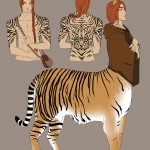 [26]
[26] 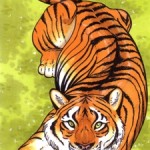 [27]
[27] 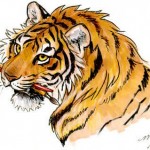 [28]
[28]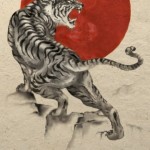 [29]
[29] 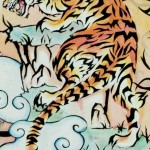 [30]
[30] 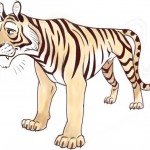 [31]
[31] [32]
[32] 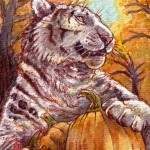 [33]
[33]  [34]
[34]
eBestiary Bibliography
Bibliography for Natural History:
Wikipedia. “Sumatran Tiger.” Wikipedia. Wikimedia Foundation. Web. 19 Apr. 2012. <http://en.wikipedia.org/wiki/Sumatran_tiger>.
“tiger.” The Hutchinson Unabridged Encyclopedia with Atlas and Weather guide. Abington: Helicon, 2010.Credo Reference. Web. 19 May 2012.
Jolly, Rajan. “Tiger Breeds Across the Globe.” Tiger Breeds Across the Globe. Http://ezinearticles.com, 2011. Web. 15 May 2012. <http://ezinearticles.com/?Tiger-Breeds-Across-the-Globe&id=5672652>.
World Wildlife Fund. “Tiger OVERVIEW.” Worldwildlife.org. World Wildlife Fund. Web. 2 May 2012. <http://www.worldwildlife.org/species/finder/tigers/index.html>.
National Geographic. “THE SUMATRAN TIGER.” TIGERS IN CRISIS. Web. 2 May 2012. <http://tigersincrisis.com/sumatran_tiger.htm>.
Sumatran Tiger Trust. “Sumatran Tiger.” SUMATRAN TIGER TRUST. The Sumatran Tiger Trust. Web. 2 May 2012. <http://www.tigertrust.info/sumatran_tiger_tiger.asp>.
Bibliography for Cultural Research:
Jolly, Rajan. “Myths and Legends of the Tiger.” Home » Reference and Education. Http://ezinearticles.com, 10 Jan. 2011. Web. 15 May 2012. <http://ezinearticles.com/?Tiger-Breeds-Across-the-Globe&id=5672652>.
Jolly, Rajan. “5 Proverbs You May Hear on Tiger Tours and What They Mean
.” Home » Reference and Education. Http://ezinearticles.com, 30 Mar. 2011. Web. 15 May 2012. < http://ezinearticles.com/?5-Proverbs-You-May-Hear-on-Tiger-Tours-and-What-They-Mean&id=6116285>.
Hee-sung, Kim. “White Tiger to Roar Loud and Proud in 2010.” Culture. Korea.net, 1 Jan. 2010. Web. 3 May 2012. <http://www.korea.net/NewsFocus/Culture/view?articleId=80148>.
Facts-Info-Intro: pictures
[1] 1 Panthera_tigris_sumatrae_(Sumatran_Tiger)_close-up:
Greverod. Panthera Tigris Sumatrae (Sumatran Tiger) Close-up. 2007. Photograph. San Antonio Zoo. File: Panthera Tigris Sumatrae (Sumatran Tiger) Close-up.jpg. Wikipedia, 10 Sept. 2007. Web. 14 Apr. 2012. <http://ja.wikipedia.org/wiki/%E3%83%95%E3%82%A1%E3%82%A4%E3%83%AB:
Panthera_tigris_sumatrae_(Sumatran_Tiger)_close-up.jpg>.
[2] 4 Ref 2 sumatran_tiger_male_01tfk:
Niraj. Sumatran_tiger_male_01tfk.jpg. 2008. Photograph. Wild Life. Niraj’s Gallery. Picasa, 11 Aug. 2008. Web. 14 Apr. 2012. <http://picasaweb.google.com/lh/photo/KRtu-cfuDm838IW9-M8y7g>. (animal wall photo)
[3] Ref 11 Sumatran_tiger_(male):
Sumatran_tiger_(male). Photograph. Animals. Wallpapers. wallpapers.pixxp.com. Web. 19 Apr. 2012. <http://wallpapers.pixxp.com/15.htm>.
Subspecies:
[4] tiger_subspecies_by_tardiscat-d1388zh:
Parks, Jenny. Tiger Subspecies. Digital image. Http://jennyparks.deviantart.com. DeviantART, 26 Sept. 2007. Web. 19 Apr. 2012. <http://jennyparks.deviantart.com/gallery/?q=tiger#/d1388zh>.
History-Evolution: pictures
[5] 5 TigerSkelLyd1:
Lydekker, Richard. TigerSkelLyd1. Digital image. File:TigerSkelLyd1.png. Wikipedia / Royal Natural History Volume 1, 12 Oct. 2010. Web. 19 Apr. 2012. <http://en.wikipedia.org/wiki/File:TigerSkelLyd1.png>.
[6] 7 lion and tiger skeleton zsdfgsdfs:
Warsaw.sharks77551. Zsdfgsdfs. 2010. Photograph. Lion and Tiger Skeleton. Lion and Tiger Skeleton. Http://animalsversesanimals.yuku.com, 21 Mar. 2011. Web. 19 Apr. 2012. <http://animalsversesanimals.yuku.com/reply/38746#.T8QL7dVYuyo>.
[7] Sumatran Tiger Skull 0901a9d3555c:
Prehistoricstore.com. Panthera Tigris, Sumatran Tiger Skull. Photograph. Replicas.Panthera Tigris, Sumatran Tiger Skull. Prehistoric Planet Store. Web. 19 Apr. 2012. <http://www.prehistoricstore.com/item.php?item=1865>.
[8] P_tigris_sumatrae_map1:
AtikuX. P Tigris Sumatrae Map1.png. Digital image. File:P Tigris Sumatrae Map1.png. Wikipedia, 17 Sept. 2008. Web. 19 Apr. 2012. <http://en.wikipedia.org/wiki/File:P_tigris_sumatrae_map1.png>.
[9] Map of Indonesia:
Indo.com. “Indonesia.” Map. Indonesia. Print.
[10] 11 Big Cat Phylogentic tree:
Sul, Seung-Jin, and Tiffani L. Williams. Big Cat Phylogenies, Consensus Trees, and Computational Thinking. Http://www.cs.tamu.edu/academics/tr/2010-7-3. Texas A&M University, 3 July 2010. Web. 27 May 2012. <http://www.cs.tamu.edu/academics/tr/2010-7-3>.
[11] [12] 12 journal.pbio.0020442.g003 (a) & (b):
Luo S-J, Kim J-H, Johnson WE, Walt Jvd, and Martenson J. Phylogenetic Relationships among Tigers from MtDNA Haplotypes. Digital image. Phylogeography and Genetic Ancestry of Tigers (Panthera Tigris). PLoS Biology, 7 Dec. 2004. Web. 27 May 2012. <http://www.plosbiology.org/article/info%3Adoi%2F10.1371%2Fjournal.pbio.0020442#aff3>.
Tigers in Culture: pictures
[13] Japan 1 tiger-dragon-screens-e:
Yamada, Yorikiyo. Tiger and Dragon. 1560. The Minneapolis Institute of Arts. Japanese Tiger and Dragon. The Minneapolis Institute of Arts, Mar. 2005. Web. 19 Apr. 2012. <http://www.artsmia.org/education/teacher-resources/pnt-objectinfocus.cfm?v=33>.
[14] Japan 2 Ref 15 4 n11614:
Randy, M. Japanese style painting of a tiger. Digital image. Japanese Tiger Drawing. ZIMBIO, 17 Jan. 2011. Web. 13 Apr. 2012. <http://www.zimbio.com/Picture+of+Tigers/articles/2M8lob1hjr2/Japanese+Tiger+Drawings>.
[15] Japan 3 japanese_tiger_full_back_tattoo_design:
Tattooan. Japanese Tiger Full Back Tattoo Design.
[16] China 1 11f23e2f8d539db578494b306675:
Chinese Artist. 581163i. Iconographic Collections, 581163i. Web. 19 Apr. 2012. <http://catalogue.wellcome.ac.uk/search~S5/o?SEARCH=581163i&searchscope=5>.
[17] India 1 8d792312e8019626699cbed251dc:
Varma, Ravi. 26596i. 1900. Iconographic Collections, Bombay. 26596i. Ravi Varma. Web. 19 Apr. 2012. <http://catalogue.wellcome.ac.uk/search~S5/o?SEARCH=26596i&searchscope=5>.
[18] Korea 1 sanshin+of+sinheongsa+seoraksan+with+another+great+tiger:
Sanshin of Sinheongsa Seoraksan with Another Great Tiger. Daoism. Mountain Spirits of Korea. Http://northstarmartialarts.com, 12 Aug. 2010. Web. 19 Apr. 2012. <http://northstarmartialarts.com/blog1/?p=1746>.
[19] Modern 1 jungle-book-shere-khan:
Kahl, Milt. Jungle Book Shere Khan. Digital image. Disney – the Dettol of Storytelling?Dettoldisney.wordpress.com, 12 Aug. 2011. Web. 19 Apr. 2012. <http://dettoldisney.wordpress.com/2011/12/08/the-jungle-book-vs-the-jungle-books/>.
[20] Modern 2 ht_tony_tiger_071119_ssv:
Kolkey, Eugene. Ht_tony_tiger_071119_ssv. Digital image. TWIG AND BONE. Flickr Photostream, 25 Sept. 2010. Web. 19 Apr. 2012. <http://twigandbone.blogspot.com/2010/09/new-and-old-guest-blog-by-nate.html>.
[21] Modern 3 Tigger-Disney-Clip-Art-Animated-ClipArt-3:
Milne, A. A., and Shirley S. Lasswell. Tigger-Disney-Clip-Art-Animated-ClipArt-3. Digital image. No Pearls. Blogger, 18 Jan. 2011. Web. 19 Apr. 2012. <http://nopearls.blogspot.com/2011/01/battle-hymn-of-tigger-mama.html>.
[22] Other 1 The Tammany Tiger Loose:
Nast, Thomas. “The Tammany Tiger Loose.” The Tammany Tiger Loose [New York] 1871, Harper’s Weekly sec.: 1056-057. Print.
[23] Other 2 tiger from Fruits basket:
Takaya, Natsuki. Fruits Basket. 1999. Manga and anime involving a family’s curse to turn into one of the animals of the Zodiac when embracing the opposite sex.
[24] Other 3 weretiger_by_koutanagamori-d30nyog:
Koutanagamori. WereTiger. Digital image. DeviantART, 2010. Web. 25 Apr. 2012. <http://koutanagamori.deviantart.com/art/WereTiger-182516560>.
[25] Other 4 Stripes_and_Spots_by_peanutchan:
Peanutchan. Stripes and Spots. Digital image. Http://peanutchan.deviantart.com. DeviantART, 10 Apr. 2010. Web. 19 Apr. 2012. <http://peanutchan.deviantart.com/gallery/?q=stripes#/d2nfx7s>.
Examples of Other People’s Work:
[26] Commission___Daven_by_3712:
3712. Commission – Daven. Digital image. Http://3712.deviantart.com. DeviantART, 21 Aug. 2010. Web. 2 May 2012. <http://3712.deviantart.com/gallery/28100736#/d2wwpjn>.
[27] Ref 16 tiger:
Ahkahna. Tiger Repose. Digital image. Http://ahkahna.deviantart.com. DeviantART, 17 July 2007. Web. 19 Apr. 2012. <http://ahkahna.deviantart.com/gallery/?q=tiger#/dzqa8x>.
[28] Ref 17 Tiger_Artist_badge:
Giles (SpaceCat), Megan. Badge.jpg. Digital image. Megan Giles (SpaceCat) —2/8. Http://yerf.metafur.org, 6 Dec. 2001. Web. 19 Apr. 2012. <http://yerf.metafur.org/gilemega>.
[29] Ref 21 Asian Tiger Art Poster Print:
TigerHouseArt. Asian Tiger Art Poster Print. Springfield. Asian Tiger Art Poster Print. Etsy. Web. 19 Apr. 2012. <http://www.etsy.com/listing/59204978/asian-tiger-art-poster-print>.
[30] Ref 25 Year_of_the_Tiger_by_Dismay666:
Dismay666. Year of the Tiger. Digital image. Http://dismay666.deviantart.com. DeviantART, 17 Feb. 2010. Web. 19 Apr. 2012. <http://dismay666.deviantart.com/gallery/?q=tiger#/d2k02yc>.
[31] Ref 26 3 tiger2-1024×737:
Admin. Big Cat Drawings: Tiger. Digital image. Celiabullwinkel.com. Celiabullwinkel.com, 30 Sept. 2009. Web. 19 Apr. 2012. <http://www.celiabullwinkel.com/uncategorized/big-cat-drawings-tiger/>.
[32] Ref 27 Byako 002:
Fushigi Yuugi. #73069. Digital image. Zerochan/Watase Yuu/Fushigi Yuugi/#73069. Zero Chan. Web. 19 Apr. 2012. <http://www.zerochan.net/73069>.
[33] Ref 28 khalamea_card_big:
Thornwolf. Khalamea ACEO. Digital image. Http://thornwolf.deviantart.com. DeviantART, 4 Nov. 2007. Web. 19 Apr. 2012. <http://thornwolf.deviantart.com/gallery/?q=aceo#/d15406x>.
[34] Ref 29 how-to-draw-a-cartoon-tiger:
Dragon Art. How to Draw a Cartoon Tiger. Digital image. How to Draw a Cartoon Tiger. DragonArt.com. Web. 19 Apr. 2012.


